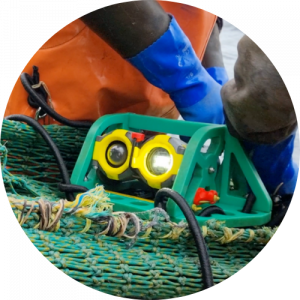
The sun is rising and PhD student Jasmine Somerville gets ready for yet another deployment of the Pisces underwater lights. This time, from aboard the Marine Biological Association’s research vessel named MBA Sepia. She shares: “In fishing, a lot of the time you think that once fish enter the net, there is no way out”. However, these underwater videos show that this is not always the case.
Jasmine’s research is concerned with identifying links between fish vision and behaviour. Since starting her studies in 2019, Jasmine has been intrigued by the use of light as a bycatch reduction method. Within her research, she has worked with Pisces LED Lights, developed by SafetyNet Technologies, to study how different species react to their presence underwater. “I started my PhD in late 2019. Then, in 2020, I started using Pisces with BRUVs in Falmouth, and now I’m deploying them on a trawl from a research vessel”, shares the researcher.
While pairing Baited Remote Underwater Video (BRUV) with Pisces has allowed Jasmine and fellow researchers to analyse which species were more affected by the presence of light, it failed to capture their behaviour in a fishing environment. So, it was time to start adding cameras to fishing nets.
Jasmine again turned to SafetyNet Technologies for a technological solution and began to deploy CatchCam underwater cameras on the trawls. Besides allowing scientists and the crew to observe the effectiveness of the Pisces LED lights as a bycatch reduction device, the CatchCam camera also lets them gain a clearer insight into the behaviour of the catch both in and around the fishing gear.
Footage recorded with a CatchCam camera deployed during scientific trials aboard the FV MBA Sepia.
The footage above was recorded by a CatchCam camera developed by SafetyNet Technologies. It’s a small and sturdy device that was created in collaboration with fishermen to support their fishing operations. From the footage, we can clearly see a blonde ray (Raja brachyura) counteracting the water flow. Despite being towed at 2-3 knots speed, the skate seems to use its body shape to its advantage, to escape out of the mouth of the net.

Jasmine shares: “We’ve seen this behaviour repeatedly on these videos, but only the larger skates can do it”. The smaller skates and fish get pulled back by the water flow and swept up to the back of the net.
Being able to capture these behaviours on video opens questions about the design of fishing equipment. For instance, “future gear modifications could look at a skate-specific release near the mouth of the net, or there could be modifications to the bottom of the net to allow flatfish to escape,” adds the researcher.
That said, this decision can be made on a vessel-by-vessel basis in order to make operations more selective according to the target catch.
Science tells us that fish respond to light. However, this can be hard to prove in a commercial fishing environment. This is due to the many environmental variables at play such as turbidity, water flow and gear type – which can all affect fish behaviour.
Light is not the solution to every fishing scenario “but where it works, it has been shown to be very effective”, shares PhD researcher Jasmine Somerville.
One big part of her research is to understand the vision of marine species and how they respond to light underwater. For instance, one species might react strongly to a certain colour, while a different species might show no reaction. The Pisces lights used during trials can be set to different colours, brightness and flashing mode. Thus, supporting varied experimental set-ups.
As a general rule though, fish and marine life seem to respond to lights that are more stimulating to their vision. While more in-depth research is needed, light technology can already be efficiently used for illuminating escape panels or for highlighting the net to certain species that are able to see the light.
While this was the first time deploying CatchCam cameras, straight away they helped Jasmine identify gaps in her bycatch study: “We could see the background light in the ocean, and how different fish species swam in the net, which helped us get a picture of what is going on down there”.
These observations can support future research. Moreover, they are opening the way to a better understanding of fish behaviour for bycatch reduction and gear efficiency.
You can learn more about Jasmine’s research in her recent documentary in collaboration with The Biome Project.
We look forward to sharing more updates about her ongoing trials. Subscribe to our mailing list below to keep up to date with the latest underwater videos and CatchCam deployments.
***
Update from April 2024: Jasmine has now been awarded a Doctorate and published a paper on her innovative work utilizing vision modelling for designing bycatch reduction devices using light. Access the paper here.
Sign up to our mailing list and get product information, special offers and the latest underwater videos recorded with CatchCam.






Enter this giveaway for the chance to try an underwater camera on your fishing vessel, with the help of a SafetyNet Technologies expert.